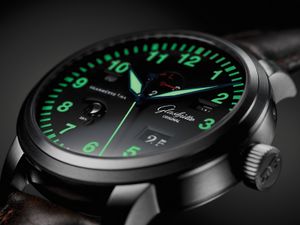Luminescence/en: Unterschied zwischen den Versionen
Zur Navigation springen
Zur Suche springen
| Zeile 1: | Zeile 1: | ||
'''Luminescence''' | '''Luminescence''' | ||
{{other languages|[[Lumineszenz|de]]|[[Luminiscencia|es]]|[[Luminescence/fr|fr]]|[[Luminescenza/it|it]]|[[Luminescentie/nl|nl]]|[[Люминесценция|ru]]}} | {{other languages|[[Lumineszenz|de]]|[[Luminiscencia|es]]|[[Luminescence/fr|fr]]|[[Luminescenza/it|it]]|[[Luminescentie/nl|nl]]|[[Люминесценция|ru]]}} | ||
| − | [[Bild:GO Senator Navigator Ewiger Kalender 4.jpg|thumb| | + | [[Bild:GO Senator Navigator Ewiger Kalender 4.jpg|thumb|Luminescent hands and hourmarkers]] |
Luminescence is light that usually occurs at low temperatures, and is thus a form of cold body radiation. It can be caused by chemical reactions, electrical energy, subatomic motions, or stress on a crystal. The dials, hands, scales and signs of aviation and navigational instruments and markings are often coated with luminescent materials, in a process known as luminising. | Luminescence is light that usually occurs at low temperatures, and is thus a form of cold body radiation. It can be caused by chemical reactions, electrical energy, subatomic motions, or stress on a crystal. The dials, hands, scales and signs of aviation and navigational instruments and markings are often coated with luminescent materials, in a process known as luminising. | ||
Version vom 17. März 2009, 02:54 Uhr
Luminescence
| other languages: de es fr it nl ru |
Luminescence is light that usually occurs at low temperatures, and is thus a form of cold body radiation. It can be caused by chemical reactions, electrical energy, subatomic motions, or stress on a crystal. The dials, hands, scales and signs of aviation and navigational instruments and markings are often coated with luminescent materials, in a process known as luminising.
See also: Leuchtfarbe.
